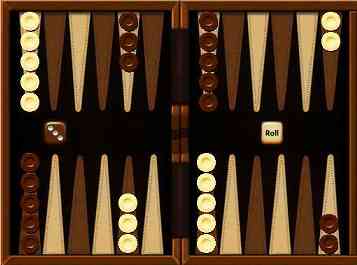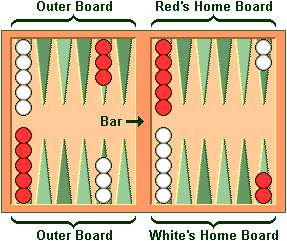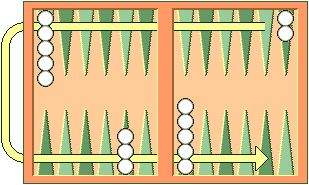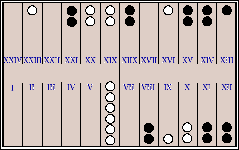Tavli - Greece's national board game
"This game is a part of the Cretan way of life!"

In every Greek kafeneio you can see men playing the beloved Greek game of 'Tavli'. It looks a bit like the 'western' game of backgammon. Sometimes they play this very quietly, contemplatively, sometimes the situation is very hectic and noisy. It's played for fun and sometimes also for money or a gamble, another favorite sport of many Greeks.

A board with the checkers in their initial position

Direction of movement of White's checkers. Red's checkers move in the opposite direction
The object
of the game is for a player to move all of his checkers into his
own home board and then bear them off. The first player to bear
off all of his checkers wins the game. The starting positions are
the master positions, called 'mana' in Greek.
To start the game, each player throws a single dice. This
determines the player to go first. If equal numbers come up, then
both players roll again until they roll different numbers. The
player throwing the higher number now moves his checkers according
to the
numbers showing on both dice. After the first roll, the players
throw two dice and alternate turns. The roll of the dice indicates
how many points, or pips, the player is to move his checkers. The
checkers are always moved forward. Please see the links at the
bottom
of this page for more details.
***
This game is
one of the oldest games in existence, dating back almost
5000 years, and is believed to have been developed by the ancient
Egyptians. Using 15 stones, two dice, one board and a winner's attitude,
try to move your stones off the table before your opponent does.
The ancient Greeks played it. So did the Romans. The game we know
today was refined in England in the seventeenth century, which is
also when it acquired the name backgammon. One significant innovation
of the twentieth century was the addition of the doubling cube in
the 1920s. This is not introduced in Tavli.
Gaming boards of 3 x 10 squares have been found extensively in ancient Egyptian archaeological sites. The game was known to the ancient Egyptians as the Game of Thirty Squares or Senet (sometimes Senat). The exact rules are not known. Similar boards have also been found consisting of 3 x 12 squares, 3 x 6 squares and other patterns - it's not clear if these are different games or mere variants. A number of boards have been found which feature Senet on one side and another popular Egyptian game, the Game of Twenty Squares, on the other.
Backgammon-type games have been played for thousands of years in all parts of the world and certainly during the Egyptian, Greek and Roman eras. The Romans left a great deal of evidence of a game they called Ludus Duodecim Scriptorum, the game of the twelve lines. The game is possibly derived from the Egyptian Senat having a topological set of 3 x 12 points and being played with 3 x 6 sided dice but, again, the rules have never been fully ascertained. In the first century AD, Ludus Duodecim Scriptorum seems to have been replaced by a variant with only 2 rows of 12 points, a game which by the 6th century was called 'Alea'. Both these games and others were also referred to as 'Tabula', which was a generic game for 'boardgame' and in early mediaeval times was usually used to mean the most popular boardgame, Duodecim Scriptorum/Alea/Backgammon, in the same way that the generic term 'football' normally means 'soccer' in England today.

Tabula, Roman board game, emperor Zeno in 480 AD
In Asia, the game of Nard appeared sometime prior to 800 AD, in South West Asia or in Persia depending upon which version of history one believes, and variants are played today throughout the continent. Chinese history gives that t'shu-p'u, the Chinese name for Nard was invented in Western India, arrived in China during the Wei dynasty (220 - 265 AD) and became popular from 479 to 1000 AD. In Japan the game was called Sugoroko and was declared illegal during the reign of Empress Jito (690 - 697 AD). Nard, in turn, seems to have been introduced into Europe via Italy or Spain following the Arab occupation of Sicily (902 AD).
The first mention of the game in English print was in The Codex Exoniensis published in 1025: "These two shall sit at Tables...". Tables was probably brought to England by men returning from the Crusades. Many of them stayed for a long time on Crete and Malta. Nard or Tables was played throughout Europe during the middle ages and became very popular in English Taverns, although Chess overtook it as the more popular game in the fifteenth century. By the end of the sixteenth century, Tables had, for some reason, become a generic term for any game played on a flat surface or table. Like many games played for money, it became unpopular with the authorities in England and, until the reign of Elizabeth I, laws prohibiting the playing of Tables in licensed establishments were in force. In the early seventeenth century, however, following some modifications to the rules, the game underwent a revival and it swept across Europe again under a variety of different names which have mostly stayed the same until today. Tavli and Tables are almost synonyms.
It is a subject of debate as to whether the term Backgammon is derived from the Welsh 'back' (little) and 'gammon' (battle) or from the Saxon 'bac' (back) 'gamen' (game).
Backgammon underwent another revival before the first World War but waned during the middle of the twentieth century only to recover again in the 1970s to become the popular game it is today. It is still widely played in the Middle East as Tric-trac.
There are a whole family of variants: Chouette (3 or 4 player version), Partnership backgammon, Sixey-Acey, Dutch Backgammon, Turkish Backgammon (Moultezim), Greek Backgammon (Tavli, Portes, Plakoto, Fevga), Gioul (from the Middle East), Acey Deucey (US Forces version of Dutch Backgammon), European Acey Deucey, Russian Backgammon, Tabard Backgammon and Icelandic Backgammon (Kotra).
TAVLI
Tavli is a game consisting of three other individual games, called 'Portes' (means 'doors', two checkers together form a 'door'), 'Plakoto' (comes from the Greek verb 'plakono', which means to put something on top of something else ,in the game to put a checker on top of an opponent's checker) and 'Fevga' (pronounce: 'figa', means 'to run', and in the game reflects a fast and well positioned play in order to get to your home quarter).
Portes is the equivalent of Backgammon, with the exception of the doubling and winning with 3 points; usually this is 5 or 7 points. In Greece the exact equivalent of backgammon is called 'Vidos'. The Greeks use to play matches by alternating between the games Portes , Plakoto and Fevga.
The general differences between Greek and 'western style' Backgammon:
- • No doubling cube is used
- • Gammons and Backgammons count the same (2 points)
- • Only one pair of dice is being used and it can be thrown in either side of the board. If a dice lands on a checker or does not lay correctly, both dice must be thrown again
- • In the first game the beginner is the one, who throws the highest number. Then he rolls again and starts with these numbers (so it is possible to start with doubles). In all the following games the winner of the last game starts the new game
- • A move is done when the opponent rolls the dice: This needs some further explanation I think (X against O, X on roll): Normally O picks up the dice while X makes his move. As long as X has a checker in his hand (or his finger on it), X may change the complete move. If X has finished his move, O may throw the dice and the move is over. If O throws the dice to early, it does not count and he has to throw them again. This way of making the moves allows fast and uncomplicated games








